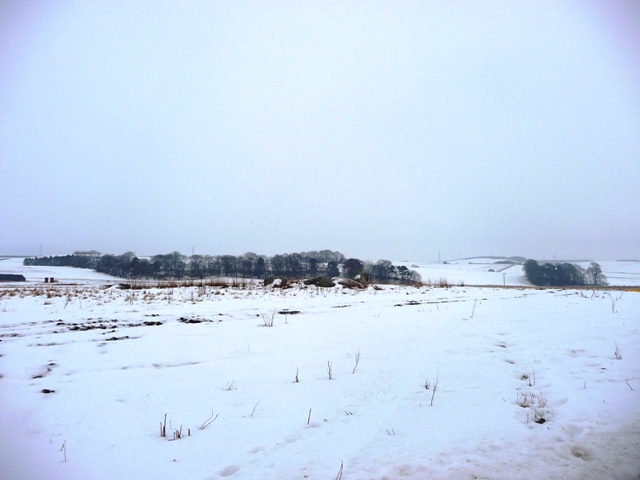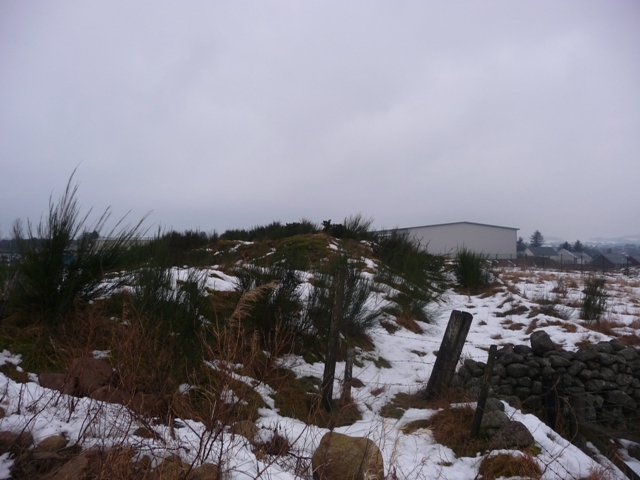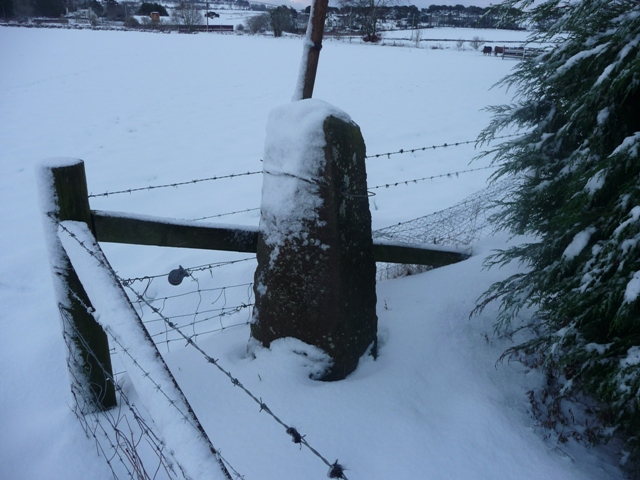




Four solid gold Iron Age neck ornaments which were found by an amateur metal detector have gone on display. Here is the BBC video
news.bbc.co.uk/1/hi/scotland/scotland_video_and_audio/8470436.stm
And some words plus the audio/video from the Edinburgh side of the country.


Yet another settlement in this area which already has Larrick and Greenlands. This seems to have been populated probably due to the closeness of the River Don and agricultural conditions.

With the ‘Crutches On Ice’ show in full swing I ventured to the Midmill Cairn and what a comical I sight I must have looked. Then again I’d resigned myself to the loony bin a long time ago.
Midmill Industrial Estate is on the south eastern outskirts of Kintore. If taking a car drive follow the signposts and drive to end of the marked road. Park in the overspill car park. The cairn is clearly visible being quite near a warehouse. From the car park it is a short walk of about 400 meters. The image on Canmore shows how this area has changed, Kintore has expanded massively and the industrial estate didn’t exist.
Originally the cairn stood at 65 meters, aligned ESE-WNW, in length but after extensive quarrying it now stands at 27 meters long, 20 meters wide and 31/2 meters high being made from earth and boulders. It is now mainly grass covered. A cist, which once could be seen, has been covered in field clearance. Possibly one kerb remains and another stone, 11/2 meters in length, might have stood.
Damage of a more recent nature has also unfortunately taken place. Some idiot on a quad bike has raced up and down the western flank damaging plant life as well as the cairn. Tuach Hill, home to a stone circle, is less than 1/2 mile away to the east.
After that it was back to the car with a couple of workmen having a good laugh at my expense. Thankfully no photos of me!
Visited 14/1/2010.







“Quite often the offerings were of some foodstuff, particularly milk. Some of the stories were named after gruagach – supernatural beings who watched over cattle and dairy work – and offerings of milk were left at these stones in return for good harvests and other agricultural benefits. Offerings of milk were left at the Clach Na Gruagach on Colonsay. Marks on the stone were said to have been caused by ropes used to tie the gruagach to it.”
Joyce Miller.
Magic and Witchcraft In Scotland.
“Cup marks on the Rothiemay recumbent stone represented the Pole Star, the constellation of the Great Bear (Ursa Major) and the brightest stars such as Artacus, Bootes, Aldebaran, Capella, Vega and Altair.”
Revd. G. F. Browne.
On Some Antiquities in the Neighbourhood of Dunecht House.
A member of the golf club phoned and told me about this burial cairn. Cheers Caroline! (Good to read that when they discovered something they immediately did something about it!) Pics later, to much snow.
I’ve walked and driven past this site plenty of times always calling it Mill Hill. Checked the OS and found I’d been wrong for a very long time. Some info for the time being.
After being driven by blizzards from the Tyrebagger looking for Caskieben Standing Stone (Gouche) probably we walked past it (the farmer says its still there) and the Bakiebutt Cairn, Little Clinterty was a much easier challenge. I turned left at the first roundabout at Blackburn, north west of Aberdeen on the A96, and pulled in at the first road, today it was blocked but on a calmer day plenty room. Little Clinterty is the farm at the bottom of the drive.
As you walk down look east and the pole holding a security light can be seen. Canmore said it had a satellite dish plus honeysuckle and Russian vines. Not today just a covering of beautifully crisp snow. It stands at over 1.8 meters tall looking over to the Tyrebagger.
Hoped to do more today but the weather won. Caskieben, Ferney Brae and the others can wait until another day.
Visited 2/1/2010.






“A ley-line runs from, or at least an alignment, runs from the RSC west of the castle (Fraser) through a pair of standing stones close to the road and onwards east to the single menhir at Lauchentilly. The first two monuments can only be visited when the field is not in crop.”
The New View From Over Atlantis.
John Michell.
On arriving at Nether Lauchentilly I was fortunate that Bill Anderson and his son returned at the same time. Whilst asking permission to park he immediately offered to drive, in his 4x4, as conditions were dodgy and it was a good 3/4 mile hike to the site. For a change I took the help and jumped into the car.
The stone is under a massive electricity pylon but for it’s protection as Bill explained. Last year the stone finally fell over and to prevent further damage it was pulled under the pylon. It would have stood at over 11/2 meters. He also said that the relevant authorities, i.e. Historic Scotland had been informed. Even better, he’d support the stones re-erection if it moved slightly, and I could see his point, from the level ground to help tractors move more freely as well as protect the stone. As of yet, no reply from the bigwigs. In one of the images Bill stands in the stones original position looking apparently towards Castle Fraser. (see Folklore)
With that we climbed back in and returned. What a nice person, a lesson for all farmers I would think.
Visited 31/12/09.

Bill stands in about its original position.

Castle Fraser is behind the clump of trees 2 in from the left.

“The magnificent Stone of Morphie sits next to the road through the farm where George Beatties ill fated romance took place. (he committed suicide after his betrothed dumped him) The 11ft monolith was once used as the core of a grain stack, and in that guise was blown down – along with the stack – by a hurricane in 1850. Six years later, digging prior to re-erection unearthed a skeleton. Folklorically, it marks the grave of the mythical Danish leader Camus.
The stone’s surface bears the fingerprints of the local kelpie, who was also enslaved by the local laird to build the now-vanished Morphie Castle. This kelpie lived in the Ponage Pool in the (river) North Esk and achieved lasting fame in the poem John o ‘Arnha’, a kind of Kincardinshire version of Tam o’ Shanter written by the tragic George Beattie. John Findlay, John o ‘Arnha’ was a boastful and authoritarian Town Officer whom Beattie knew well. The poem was turned into a play and performed at the Theatre Royal in Montrose in 1826, with the principal actor wearing Findlay’s own red coat. The action concerns the fearless John who works his way up the supernatural food chain, besting the kelpie, a group of witches, and finally Old Nick himself.”
Mysterious Aberdeenshire – Geoff Holder
‘Stand aff, ye fiend, and dread my wraith,
Or soon I’ll steek your een in death:,
Not you nor a’ the hounds of hell,
Can my undaunted courage quell.‘
John O’ Arnha – George Beattie (1883 edition)
“The irregularly-shaped Court Stane is one of those standing stones which attracts folkloric jetsam. The name could come from the site of an old feudal court of the Barony of Mondynes (which may mean there was a stone circle here – just like at Old Rayne); or perhaps it was emblematic of the authority of a Steward or Thane. More theatrically, it is said to mark where Duncan II was killed in 1094. In 2004 the stone was a bright white, courtesy of a tradition of unknown purpose maintained by the estate. In recent years the paint has not been renewed and the stone has reverted to its native grey.”
Mysterious Aberdeenshire.
Geoff Holder.
This also has the name of “Tuam-an-fhamaire”. Translated as the “Grave of the Giant”.
The Place Names Of West Aberdeenshire



The latest find is thought to be even older than the six burials previously found.
First published 23/12/09.
More on:
The final cairn of the day and it was beginning to get dangerously dark. We scrambled, over 500 meters from Glenshee 3, the last uphill often waist deep in snow drifts. Footing underneath was dodgy but we battered on. It was worth it, the sun had gone but the moon was up shining brightly. Also shining, the lights of Huntly, to the east, and Keith, to the north.
Westfolds, no riders of Rohan here, is also known as the Poor Man. It is more likely to be a natural mound than a cairn and measures at almost 17 meters wide by 11/2 meters tall and sits on the top of Norry Hill.
A very pleasant end to the day and suddenly all in the world was well. One big problem, the temperature was -16, our water bottles had frozen in our rucksacks. The descent took forever crossing bogs, streams, fences, tree stumps and very deep snow but eventually we found the track at Parkhall, from there down to the A920, back to the car and heat. Several hours after we’d started we’d finished equipment and bodies still intact.
Visited 21/12/09.
The real reason for this days climbing was Cairnborrow the three cairns at Glenshee, a pure fluke but great luck even if it added miles and aches to our journey. We’d hoped to go to Craig Dorney, hillfort, for the Solstice but ended up in one of the most beautiful places I’ve ever seen.
Images of the cairn were taken showing the sun setting and the moon rising. This cairn is some 15 meters wide and almost 2 meters high. Boulders and earth were used in the construction, and along with snow lay undisturbed except for two intrepid walkers. (more commonly known as idiots!!)
One extra cairn to go, temperature still -11.
Visited 21/12/09.





500 meters west and the long cairn can be found. To get here two deserted small farms must be past, they sit desolate like a ghost town unused for decades. I often wonder if some of the ancient tales were past down generation to generation only to vanish because of modernisation. Who knows?
Anyway this is the middle cairn of the group of three and looks straight down Park Hall valley to the Deveron way below. At some stage the long cairn was 45 meters in length but has met with some severe treatment. At least it still survives.
A much needed cup of tea and onto the next cairn only a short distance away. As for the temperature it had dropped to -11.
Visited 21/12/09.
More info about the three cairns, this being the long cairn.